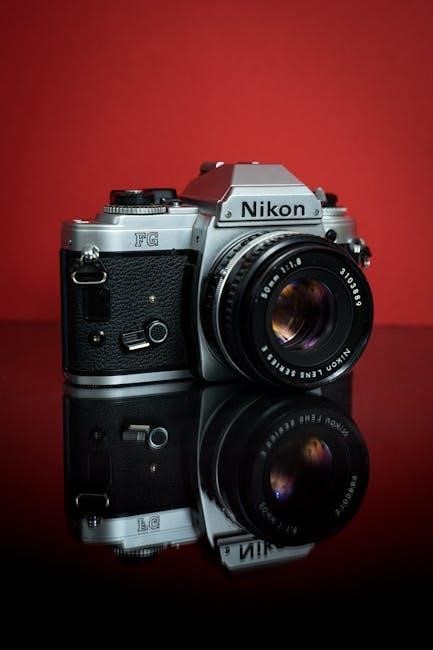The Nikon N80 is a 35mm film SLR camera known for its versatility and compatibility with various Nikon lenses, offering manual and autofocus capabilities. This manual guides users through its features, shooting modes, and maintenance, ensuring optimal performance and understanding of the camera’s functions.
1.1 Overview of the Nikon N80
The Nikon N80 is a 35mm film SLR camera designed for both amateur and professional photographers. Known for its durability and compatibility with a wide range of Nikon lenses, it supports both AF-S autofocus and manual-focus lenses. The camera features a compact, ergonomic design with intuitive controls, making it easy to handle. It is fully functional with modern lenses while maintaining compatibility with older models. Primarily sold in the U.S;, Central, and South America, the N80 is praised for its reliability and versatility. Its robust build and advanced features make it a popular choice among photography enthusiasts seeking a dependable film camera.
1.2 Historical Background
The Nikon N80, introduced in 2000, was part of Nikon’s efforts to create accessible, high-quality film cameras. It followed the success of earlier models like the N2020 and N2000, offering enhanced features. Designed primarily for the U.S. and American markets, the N80 was known for its compatibility with a wide range of lenses, including older manual-focus options. Its release marked a significant step in Nikon’s strategy to cater to both professionals and enthusiasts, ensuring a smooth transition between film and emerging digital technologies. The N80’s legacy lies in its reliability and adaptability, making it a favorite among photographers during the early 2000s.
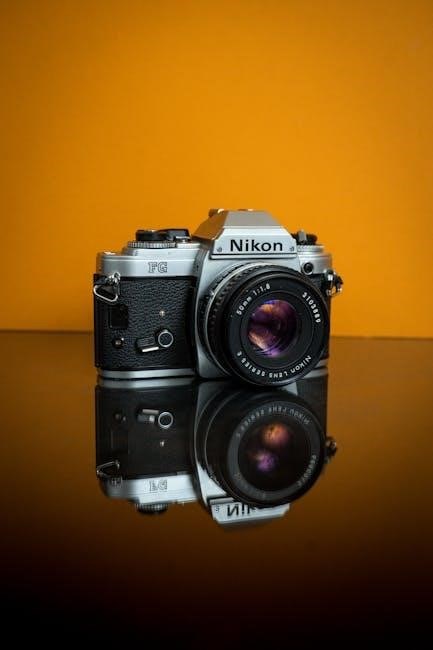
Key Features
The Nikon N80 offers an advanced autofocus system, multiple metering modes, and a durable, ergonomic design, making it a versatile choice for photographers seeking precision and reliability.
2.1 Autofocus System
The Nikon N80 features a sophisticated autofocus system, utilizing phase-detection technology for precise and rapid focus acquisition. Equipped with multiple AF points, it ensures accurate subject tracking in various lighting conditions. The system supports both single-shot and continuous autofocus modes, catering to different photographic needs. Compatible with AF-S lenses, it offers smooth and quiet focusing, while also supporting older manual-focus lenses in manual mode. This versatility makes the N80 adaptable for photographers preferring modern autofocus convenience or traditional manual control, providing a reliable performance across diverse shooting scenarios. The autofocus system’s efficiency, even in low-light environments, enhances its overall usability and appeal to both professionals and enthusiasts.
2.2 Metering Modes
The Nikon N80 offers three metering modes to cater to various lighting conditions: Matrix, Center-Weighted, and Spot. Matrix Metering evaluates light across multiple zones for balanced exposure, ideal for complex scenes. Center-Weighted Metering prioritizes the central area, suitable for portraits. Spot Metering measures light from a specific spot, ensuring precise control over high-contrast subjects. These modes provide flexibility, allowing photographers to adapt to different lighting scenarios and achieve accurate exposures. The N80’s metering system is highly regarded for its reliability and customization, making it a versatile tool for both casual and professional photography, ensuring optimal results in diverse shooting environments and lighting setups.
2.3 Build and Ergonomics
The Nikon N80 features a durable and lightweight design, combining a polycarbonate body with a comfortable grip for enhanced ergonomics. Its intuitive control layout ensures easy access to settings, making it user-friendly for photographers of all skill levels. The camera’s compact size and balanced weight distribution reduce fatigue during extended use. The N80’s build quality is robust, providing reliability in various shooting conditions. Its ergonomic design emphasizes comfort and practicality, with buttons and dials strategically placed for quick operation. This combination of durability and user-centric design makes the N80 a reliable choice for both casual and professional photography, ensuring a seamless shooting experience in diverse environments and lighting setups.
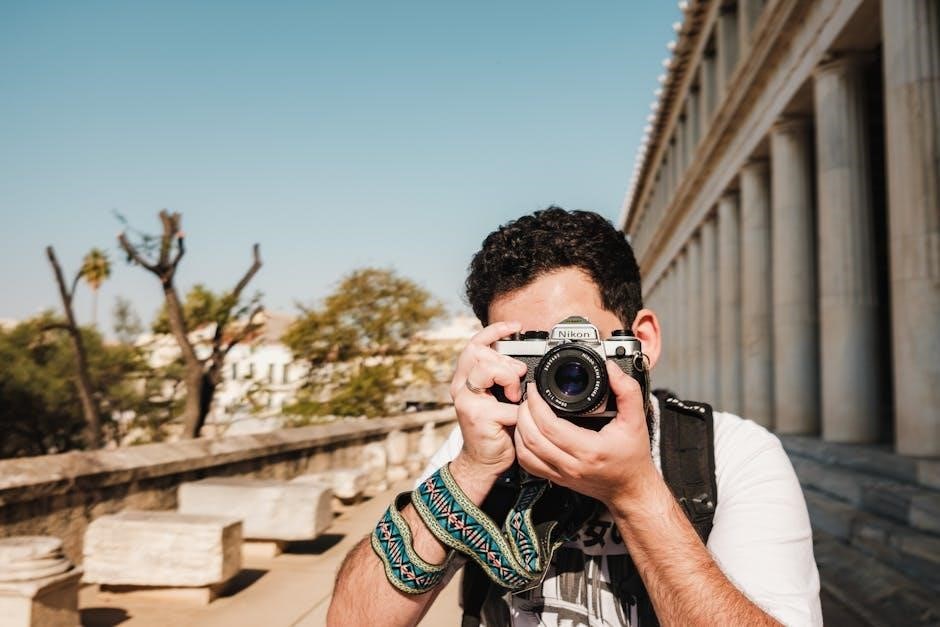
Camera Parts
The Nikon N80 includes essential components like the lens mount, viewfinder, and mode dial, ensuring compatibility with various Nikon lenses for both autofocus and manual operations.
3.1 External Controls
The Nikon N80 features a range of external controls designed for intuitive operation. The mode dial on the top allows selection of shooting modes, including Manual, Aperture Priority, Shutter Priority, and Program. The shutter release button, located on the top-right, enables half-press for autofocus and full-press to capture images. The LCD panel on the top displays essential settings like shutter speed, aperture, and remaining film count. The command dial, positioned near the shutter release, adjusts aperture and shutter speed. Additional controls include the exposure compensation button and focus area selector, ensuring easy access to key functions for precise control over photography settings.
3.2 Internal Components
The Nikon N80 houses advanced internal components that ensure reliable performance. Its autofocus system, powered by a precise motor, delivers quick and accurate focus acquisition. The camera features a built-in light meter for accurate exposure readings, supporting various metering modes. The internal mechanism includes a robust film transport system, designed for smooth loading and advancing of film. Additionally, the N80 incorporates a quartz timing system for precise shutter control, ensuring accurate exposures. These internal components work together seamlessly to provide users with a professional-grade tool for capturing high-quality images with ease, making it a dependable choice for both enthusiasts and professionals in film photography.
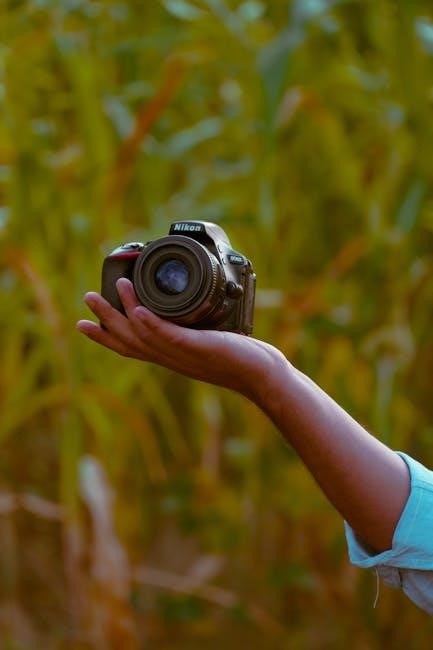
Shooting Modes
The Nikon N80 offers versatile shooting modes, including Manual, Aperture Priority, Shutter Priority, and Program Mode, providing flexibility and control for various photography scenarios and creative needs.
4.1 Manual Mode
The Manual Mode on the Nikon N80 allows photographers to gain complete control over exposure settings by adjusting both aperture and shutter speed independently. This mode is ideal for experienced photographers who prefer precise control over their creative process. When using Manual Mode, the camera’s built-in light meter assists in determining the correct exposure by providing visual feedback. The N80 also supports older manual-focus lenses, making it a versatile option for photographers who value compatibility with a wide range of optics. With Manual Mode, users can achieve their desired artistic effects by fine-tuning their settings to match the scene’s lighting conditions and their creative vision.
4.2 Aperture Priority Mode
Aperture Priority Mode on the Nikon N80 allows photographers to set the desired aperture, while the camera automatically adjusts the shutter speed to achieve the correct exposure. This mode is particularly useful for controlling depth of field, as it enables precise aperture adjustments to blur or sharpen backgrounds. The N80’s metering system ensures accurate exposures, even in challenging lighting conditions. By prioritizing aperture, users can creatively manage the visual impact of their images while relying on the camera’s automation for optimal results. This mode is ideal for portrait and landscape photography, where depth of field control is essential for artistic expression.
4.3 Shutter Priority Mode
In Shutter Priority Mode, the Nikon N80 allows photographers to manually set the shutter speed, while the camera automatically adjusts the aperture for proper exposure. This mode is ideal for capturing motion, as it enables freezing fast-moving subjects or creating artistic blur effects. Photographers can choose shutter speeds ranging from 1/8000th of a second to 30 seconds, providing precise control over motion and low-light scenarios. The N80’s metering system ensures accurate exposures, even when shooting in challenging conditions. This mode is particularly useful for sports, wildlife, and creative photography, where controlling the shutter speed is essential for achieving desired visual effects and capturing dynamic moments effectively.
4.4 Program Mode
Program Mode on the Nikon N80 is a fully automatic shooting mode designed for effortless photography. The camera automatically selects both the aperture and shutter speed to ensure optimal exposure, making it ideal for beginners or quick shooting situations. This mode is versatile and works well in various lighting conditions, allowing users to focus solely on composition. While the camera handles most settings, photographers can still adjust features like exposure compensation for fine-tuning. Program Mode is perfect for everyday photography, offering a balance between convenience and creative control, ensuring high-quality results without the need for manual adjustments. This mode simplifies the process, making it accessible for all skill levels while delivering consistent and reliable outcomes.
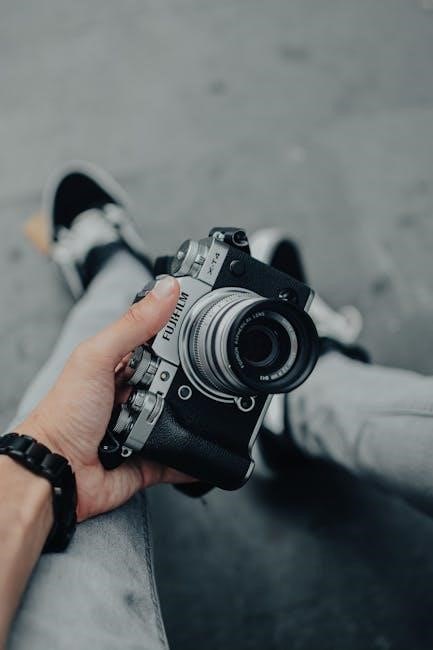
Exposure Settings
This section explains the key exposure controls, including aperture, shutter speed, and ISO sensitivity, essential for precise control over the photography process.
5.1 Aperture Control
The Nikon N80 allows precise control over aperture, enabling photographers to adjust depth of field. Aperture settings range from wide (like f/1.8) to narrow (f/16 or higher), ensuring flexibility in various lighting conditions. The camera supports both manual and automatic aperture adjustments, catering to different shooting preferences. When using AF-S lenses, aperture control is seamlessly integrated with autofocus functionality, while manual lenses require manual adjustment. Proper aperture management enhances image quality, making it a critical aspect of the exposure process.
5.2 Shutter Speed Adjustment
The Nikon N80 offers precise control over shutter speed, with a range of 1/8000th of a second to 30 seconds, plus a Bulb mode for extended exposures; Shutter speed adjustment is crucial for capturing motion and freezing or blurring elements in an image. The camera allows manual selection of shutter speeds using the command dial, while automatic modes handle this for convenience. Flash synchronization is supported at speeds up to 1/125th of a second. Proper use of shutter speed, combined with aperture and ISO, ensures optimal exposure and creative control over the final image.
5.3 ISO Sensitivity
The Nikon N80 supports ISO sensitivities from 25 to 5000, offering flexibility in various lighting conditions. ISO settings are adjusted manually via the camera’s control panel. Lower ISOs (25-400) are ideal for bright lighting, minimizing grain and ensuring sharp images. Higher ISOs (800-5000) are best for low-light scenarios, capturing images with minimal noise. The camera’s DX coding system automatically detects ISO for DX-coded films, while non-DX films can be manually set. Proper ISO selection balances image quality and lighting conditions, allowing photographers to achieve desired results efficiently. This feature is essential for optimizing exposures and maintaining image clarity across different environments.

Accessories
Nikon N80 accessories include compatible lenses, flash units, and straps, enhancing functionality and user experience. These additions allow photographers to explore various techniques and improve results.
6.1 Compatible Lenses
The Nikon N80 supports a wide range of lenses, including AF-S and older manual focus options. Compatibility ensures versatility, allowing photographers to choose the best lens for their needs. With options for various focal lengths and aperture settings, the N80 accommodates both casual and professional use. Lens compatibility is a key feature, making the camera adaptable for different photography styles and preferences. This flexibility enhances the overall shooting experience, providing users with creative freedom and precision in capturing images.
6.2 Flash Units
The Nikon N80 is compatible with various flash units, including the popular SB-800, which offers advanced features like TTL metering and wireless operation. These flash units enhance low-light photography by providing precise illumination control. The SB-800, in particular, is noted for its reliability and performance with the N80. Other compatible flash units, such as the SB-28 and SB-26, also deliver excellent results, ensuring versatility for different lighting needs. These flash units are essential accessories for photographers seeking to expand their creative possibilities with the Nikon N80, offering both power and convenience in various shooting conditions.
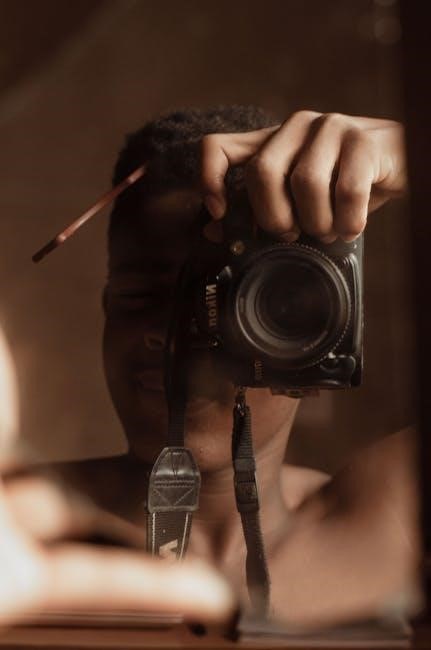
Troubleshooting
Common issues include faulty shutters and error messages. Basic troubleshooting involves checking battery connections and cleaning components. Consult the manual or a professional for persistent problems.
7.1 Common Issues
Shutter malfunctions are prevalent, often due to wear or dirt. Error messages may appear, indicating issues like lens incompatibility or internal component failures. Battery drain is another concern, especially with aging units. Additionally, improper lens mounting can cause mechanical issues, while incorrect film loading may lead to exposure problems. Users should refer to the troubleshooting section for guidance on diagnosing and resolving these issues effectively to maintain optimal camera performance and extend its lifespan.
7.2 Understanding Error Messages
The Nikon N80 displays error messages to indicate specific issues, such as lens incompatibility or internal malfunctions. Common errors include “ERR” for system failures and “FEE” for aperture issues. These messages guide users to potential problems, enabling targeted troubleshooting. Referencing the manual or online resources can help decode these messages, ensuring proper camera functionality. Always address errors promptly to prevent further damage or operational disruptions. Consulting the troubleshooting section or seeking professional assistance is recommended for unresolved issues, ensuring the camera operates efficiently and maintains its performance over time. Accurate diagnosis is key to resolving errors effectively.
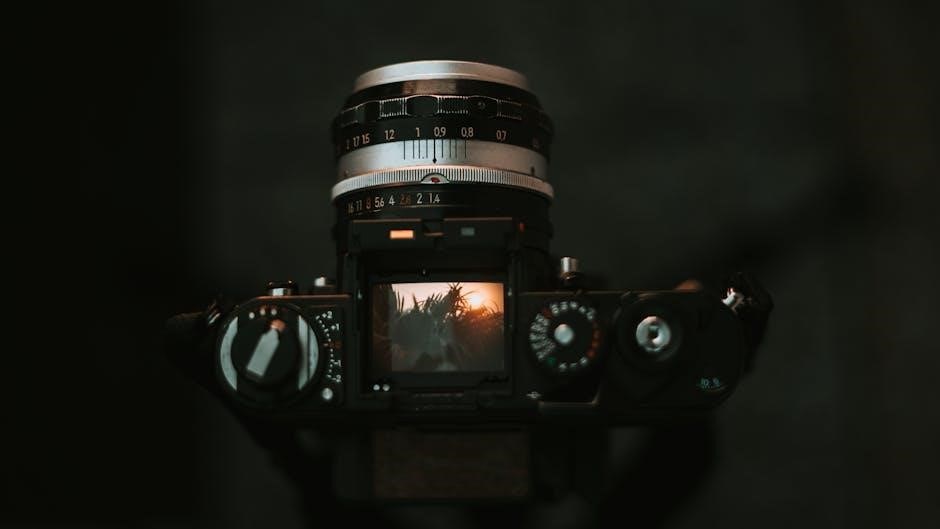
Maintenance
Regular maintenance ensures the Nikon N80’s longevity and performance. Clean the camera body, inspect the battery compartment, and check for lens compatibility to maintain functionality and reliability over time.
8.1 Cleaning the Camera
Proper cleaning is essential for maintaining the Nikon N80’s performance. Use a soft, dry cloth to wipe the camera body and exterior components. For the mirror and viewfinder, a microfiber cloth lightly dampened with distilled water is recommended. Avoid harsh chemicals or abrasive materials that could damage surfaces. Regularly inspect and clean the lens mounts and electrical contacts to ensure compatibility with lenses and accessories. Store the camera in a dry, cool environment to prevent moisture buildup and potential damage. Cleaning should be done carefully to preserve the camera’s functionality and extend its lifespan for optimal use.
8.2 Battery Care and Management
Proper battery care is crucial for the Nikon N80’s operation. Use high-quality, compatible batteries to ensure reliable performance. Avoid mixing old and new batteries or different types, as this can cause damage. When charging, use the recommended charger and avoid overcharging, as it can reduce battery life. Store batteries in a cool, dry place, away from metal objects, to prevent accidental discharge. Clean the battery contacts regularly with a soft cloth to maintain good connectivity. Replace batteries if they show signs of wear or leakage. Always test battery voltage before use to ensure optimal functionality. Following these guidelines will extend the life of your batteries and ensure your camera operates smoothly.
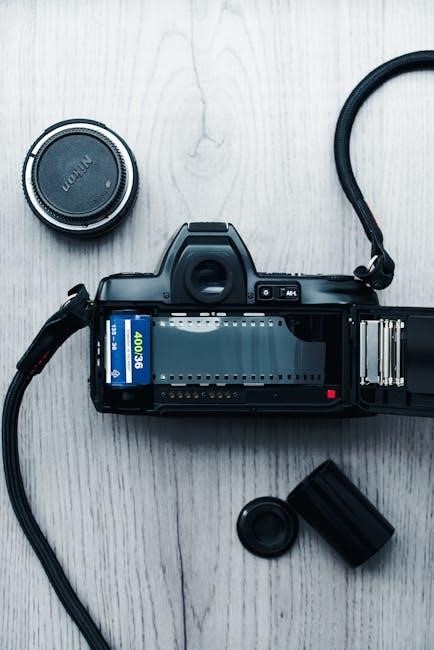
Downloading the Manual
The Nikon N80 manual can be downloaded from official Nikon websites, third-party platforms, or PDF databases. Ensure reliability and safety when sourcing the manual online.
9.1 Reliable Sources
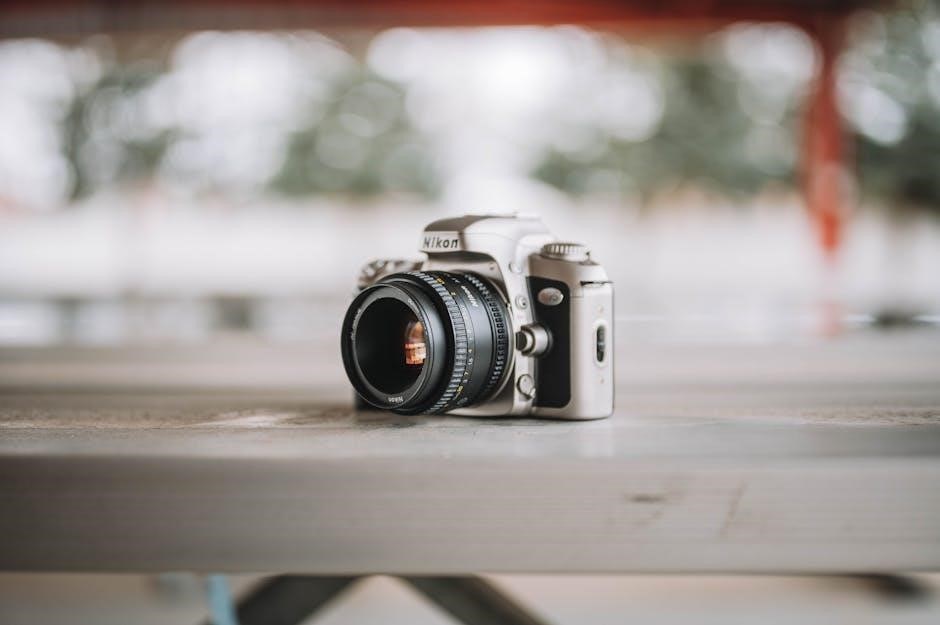
Reliable sources for downloading the Nikon N80 manual include official Nikon websites, trusted third-party PDF repositories, and reputable camera communities. Ensure the source is verified to avoid malicious files. Popular options include Nikon’s official support page, where users can search by model and download the manual directly. Additionally, platforms like ManualsLib or ManualsOnline offer free access to user manuals for various camera models, including the N80. Always check for user reviews or ratings to confirm the credibility of the source. This ensures a safe and reliable download experience for your Nikon N80 camera manual.
The Nikon N80 is a reliable 35mm film SLR camera, ideal for photography enthusiasts. Its compatibility with Nikon lenses and robust features make it a timeless choice. The manual provides comprehensive guidance, ensuring users maximize its potential and maintain it effectively for lasting performance.
10.1 Pros of the Nikon N80
The Nikon N80 is a highly versatile and durable film SLR camera, offering excellent compatibility with a wide range of Nikon lenses, including modern AF-S models. Its intuitive controls and robust build quality make it a favorite among photographers. The camera supports both autofocus and manual focusing, providing flexibility for various shooting styles. Additionally, its battery life is reliable, and the camera’s design ensures ease of use. The N80 is ideal for both enthusiasts and professionals, delivering consistent results. Its compatibility with modern lenses and accessories further enhances its value, making it a timeless choice for film photography enthusiasts.
10.2 Cons of the Nikon N80
The Nikon N80, while robust, has some limitations. It lacks modern features like digital preview or advanced metering systems. Some users find the autofocus slower compared to newer models. Compatibility issues arise with certain Sigma lenses, which only work in manual mode. The camera’s regional availability, primarily in the Americas, may limit its accessibility elsewhere. Battery consumption can be high, and finding replacement batteries may be challenging. Additionally, the N80 lacks weather sealing, making it less durable in harsh conditions. While it excels for film enthusiasts, its limitations in modern contexts and maintenance challenges make it less practical for casual users seeking convenience and advanced functionality.
